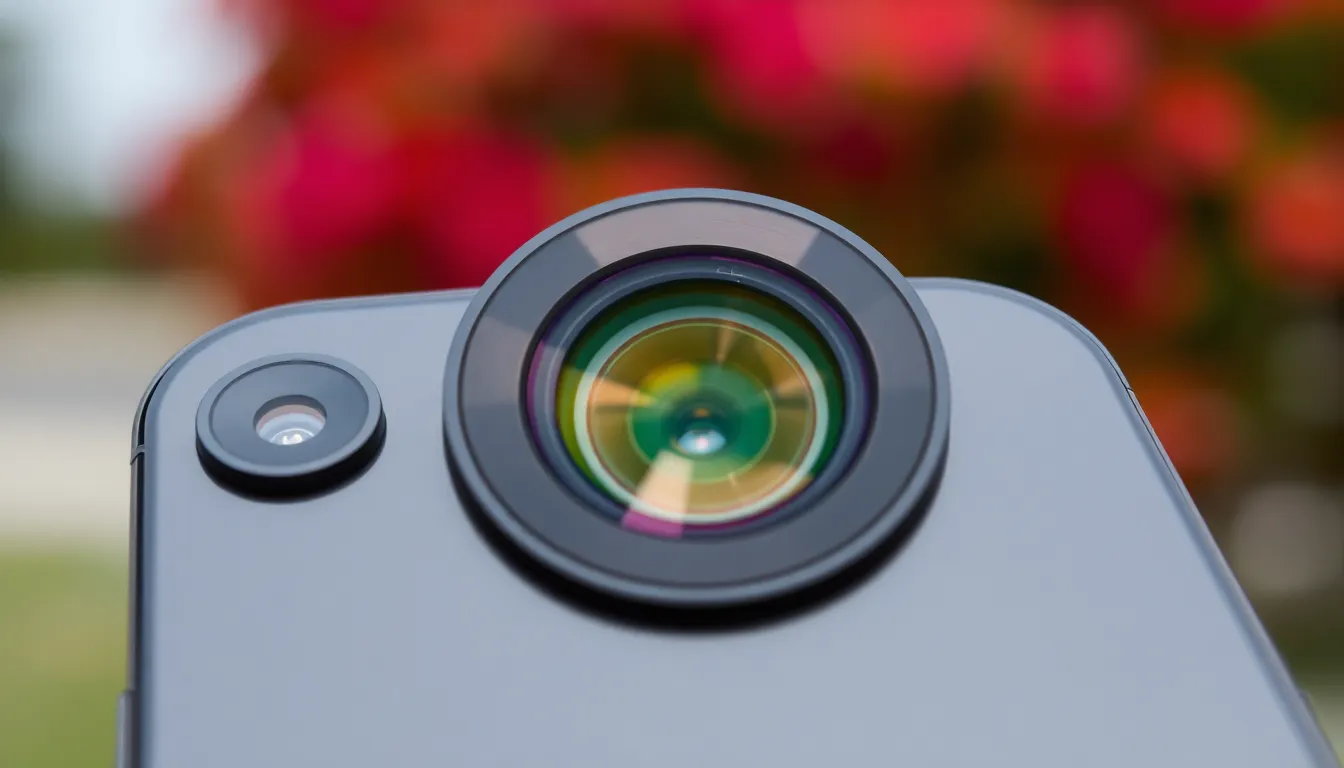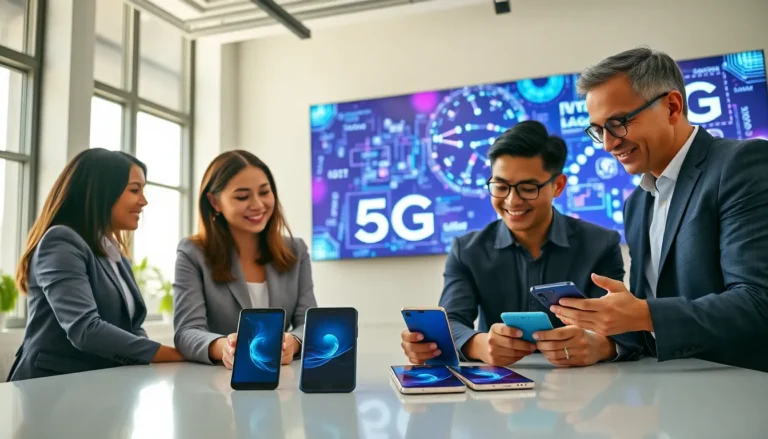Table of Contents
ToggleIn a world where every moment is Instagrammable, smartphone camera quality has become the holy grail for tech enthusiasts and casual users alike. Gone are the days of grainy selfies and blurry landscapes; today’s smartphones boast cameras that can make even a potato look good. With advancements in technology and features like multiple lenses and AI enhancements, capturing that perfect shot has never been easier—or more fun.
But let’s face it, not all smartphone cameras are created equal. Some promise professional-grade photography but deliver photos that look like they were taken with a toaster. So how do you navigate this pixelated jungle? Buckle up as we dive into the fascinating world of smartphone camera quality, exploring what makes a camera truly shine and how to pick the right one for your photographic escapades.
Overview of Smartphone Camera Quality
Smartphone camera quality varies significantly across models. Factors influencing this quality include resolution, lens types, and image processing capabilities. Resolution often plays a key role, with higher megapixel counts leading to more detailed images. Lens quality further determines how well a camera captures light and manages distortion.
Multiple lenses enhance versatility, allowing for various photography styles. Telephoto lenses facilitate closer shots without sacrificing detail, while wide-angle lenses capture expansive scenes. Additionally, manufacturers incorporate AI enhancements, improving low-light performance and optimizing settings for diverse conditions.
Image stabilization technology also contributes to smartphone camera quality. Optical image stabilization reduces blur caused by shaky hands, producing clearer shots. Digital stabilization can further refine image quality during video recording.
Another aspect involves software updates and photography modes. Software updates often enhance image processing algorithms, improving photo quality over time. Various modes, such as night mode or portrait mode, offer tailored settings for specific scenarios.
User experience varies, with some smartphones delivering consistent performance in diverse environments. Budget-friendly options may compromise on certain features, while flagship models excel in camera quality.
Ultimately, consumers ought to research reviews and specifications to find a smartphone that meets their photography needs. Prioritizing key features allows users to capture moments with clarity and creativity.
Factors Influencing Camera Quality

Several key factors significantly affect smartphone camera quality. Understanding these components helps consumers choose smartphones that deliver exceptional photography.
Sensor Size and Type
Sensor size directly impacts image quality. Larger sensors capture more light, leading to clearer images with less noise. The type of sensor also plays a crucial role; for instance, CMOS sensors generally provide better performance in low-light conditions compared to CCD sensors. Smartphones equipped with larger, high-quality sensors tend to excel in capturing detail and color accuracy. As technology advances, brands increasingly integrate advanced sensor technologies, enhancing overall image quality.
Lens Quality
Lens quality affects sharpness and clarity. High-quality lenses minimize distortion, ensuring accurate portrayal of scenes. Multi-element lens designs contribute to better light transmission, resulting in improved photos, especially in challenging conditions. Wide apertures in lenses allow more light to enter, enhancing performance during low-light shooting. Additionally, specialized lenses enable different photography styles, from macro to telephoto. Superior lens construction remains a crucial aspect for delivering outstanding images in smartphone cameras.
Image Processing Software
Image processing software optimizes images after capture. Advanced algorithms enhance color accuracy, adjust exposure, and reduce noise effectively. Smartphones that incorporate powerful image processors typically produce superior results, especially in complex lighting situations. AI-driven features further refine images by recognizing scenes and applying optimal settings. Consistent software updates also improve performance over time, ensuring that devices adapt to evolving photography trends and user needs. Quality image processing cements its importance in smartphone camera quality, directly influencing how photos appear.
Comparison of Leading Smartphone Brands
Smartphone cameras vary significantly across brands. The following sections highlight the strengths and weaknesses of Apple, Samsung, and Google.
Apple
Apple consistently sets high standards for smartphone camera quality. Flagship models feature advanced sensors and high-resolution lenses, ensuring superior image clarity. The iPhone’s computational photography excels in low-light situations, producing vibrant and accurate colors. Features such as Smart HDR and Night mode optimize photos, capturing impressive details with minimal noise. Apple invests in software updates, continuously enhancing photography capabilities. User experiences often commend the ease of use and intuitive interface, making it accessible for casual photographers and professionals alike.
Samsung
Samsung leads with versatile camera systems focused on innovation. Their flagship devices include multiple lenses, offering wide-angle, telephoto, and ultra-wide options. High-resolution sensors deliver exceptional detail, making it ideal for diverse photography styles. Samsung’s Night mode and AI features enhance dark conditions, resulting in clearer images. Video recording capabilities also impress, with options for 4K and Super Steady features. Regular software updates ensure that camera performance remains competitive, catering to users’ evolving demands.
Google’s smartphone cameras emphasize software-based photography. With advanced image processing, they achieve remarkable results without relying on high megapixel counts. Pixel models are known for Night Sight, enabling stunning low-light photography. User-friendly features like Top Shot intelligently select the best images, minimizing blinks and distractions. Though the hardware may not match competitors, the integration of machine learning sets Google apart in achieving natural-looking images. Frequent software enhancements continue to refine performance and maintain user satisfaction in photography.
Impact of Camera Quality on User Experience
Camera quality significantly influences user experience in several ways. High-resolution images create an immediate impression, allowing users to capture moments in detail. Enhanced low-light performance makes nighttime photography enjoyable, providing clarity in challenging conditions. Users appreciate versatile lens options, granting them the ability to switch between wide-angle and telephoto perspectives.
Smartphone cameras equipped with advanced image stabilization lead to steadier shots. These clearer photos improve social media sharing, with users seeking quality over quantity. AI enhancements further refine images, adjusting settings automatically based on scene conditions. A well-optimized camera can reduce editing time, contributing to a more efficient workflow for users.
User satisfaction often correlates with the camera’s performance. Flagship models from brands like Apple and Samsung frequently deliver superior results, showcasing consistent quality across various scenarios. Budget-friendly options might lack some features but can still provide satisfactory results for casual users.
Feedback from photographers indicates that camera quality impacts creative expression. Users find that better cameras encourage experimentation, pushing them to explore different genres like portrait or landscape photography. A solid camera can inspire artistic endeavors, boosting user confidence.
Camera quality not only defines image output but also shapes how users interact with their smartphones. It enables self-expression and creativity, emphasizing the need for informed choices when selecting a device.
Future Trends in Smartphone Cameras
AI integration plays a significant role in enhancing smartphone photography. Features like scene recognition enable automatic adjustments, leading to better image quality. Photographers can expect smarter enhancements that deliver optimal settings without manual input.
Higher sensor resolutions are becoming common, providing clearer, more detailed images. Smartphone manufacturers are focusing on larger sensors, aiming to improve low-light performance substantially. These advancements contribute to a noticeable difference in image clarity.
Additionally, computational photography continues evolving, pushing the limits of what smartphone cameras can achieve. This technology allows for sophisticated image processing that rivals traditional cameras. Expect seamless blending of multiple images to create stunning final photos.
Emerging trends also include improved optics and lens quality. Manufacturers are designing lenses that minimize distortion and maximize sharpness, which enhances overall image quality. The variety of lenses available on smartphones caters to diverse photography preferences.
Video capabilities are advancing rapidly as well. Higher frame rates and resolutions are standard in newer models, ensuring smooth, high-quality recordings. Users can take advantage of features like 8K recording, providing excellent detail for filmmakers and content creators.
Lastly, mobile photography accessories are gaining traction. Gimbals, attachable lenses, and advanced lighting options can enhance photography experiences significantly. Users looking to elevate their creative expression may explore these accessories as they become more integrated with smartphone technology.
Smartphone camera quality continues to shape the way people capture and share their lives. As technology advances users can enjoy higher resolution images and enhanced low-light performance that were once reserved for professional cameras. The variety of lenses and AI-driven features empower creativity and ensure that every moment can be captured beautifully.
While flagship models often lead the pack in performance budget-friendly options still offer satisfactory results for casual users. With ongoing innovations in image processing and optics the future of smartphone photography looks promising. As users become more informed about their choices they can select devices that best suit their photography needs, ensuring that every shot tells a story.






